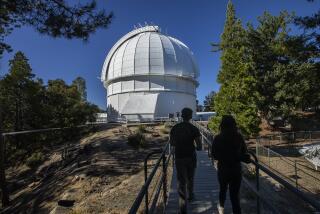Albert Whitford, 96; Key Player in Astronomy at UC Santa Cruz
Albert E. Whitford, astronomer and educator who directed UC’s Lick Observatory and moved its headquarters from Mt. Hamilton to the new UC Santa Cruz campus in 1966, has died. He was 96.
Whitford, who had returned to his native Wisconsin in 1996, died March 28 at Meriter Health Center in Madison after a short illness.
Regarded as an expert on photoelectric photometry and structure of the galaxy, Whitford headed Lick Observatory from 1958 to 1968. There he oversaw the completion in 1959 of its 120-inch Shane Telescope, then the second-largest in the world and still considered a highly productive research instrument.
Whitford and other astronomers who worked at Mt. Hamilton formed the core of the new Santa Cruz campus’ astronomy department. Whitford taught until 1973 and continued his research until last year.
The researcher and educator was also recognized for his role in building the national observatory system and leading the growth of astronomy research in the U.S. He headed a 1953 conference that laid the groundwork for the national system and in 1964 guided what became known as the Whitford Report, outlining the first of a series of 10-year plans for astronomy research.
Born in Milton, Wis., Whitford earned a bachelor’s degree from its Milton College and a master’s and doctorate in laboratory physics from the University of Wisconsin. He did post-doctoral research at Caltech and Mt. Wilson Observatory in the mid-1930s before joining the faculty of his alma mater.
Whitford worked at the University of Wisconsin from 1936 until 1958, serving the last 10 years as director of its Washburn Observatory.
Working with that school’s Joel Stebbins, Whitford greatly improved the sensitivity of the photometers they used to measure the magnitudes and colors of faint stars, clusters and galaxies. His “Whitford Reddening Curve,” which quantifies the interstellar absorption of light, helped map the distribution of stars in the Milky Way galaxy. He was also known for his studies of nuclear bulges, the blobs of stars in a galaxy’s center.
Whitford served as president of the American Astronomical Society from 1967 to 1970.
A widower, he is survived by three children and nine grandchildren. Services are planned for April 14 in Madison. Memorial contributions can be sent to Lick Observatory, Office of the Director, UC Santa Cruz, 1156 High St., Santa Cruz, CA 95064.





